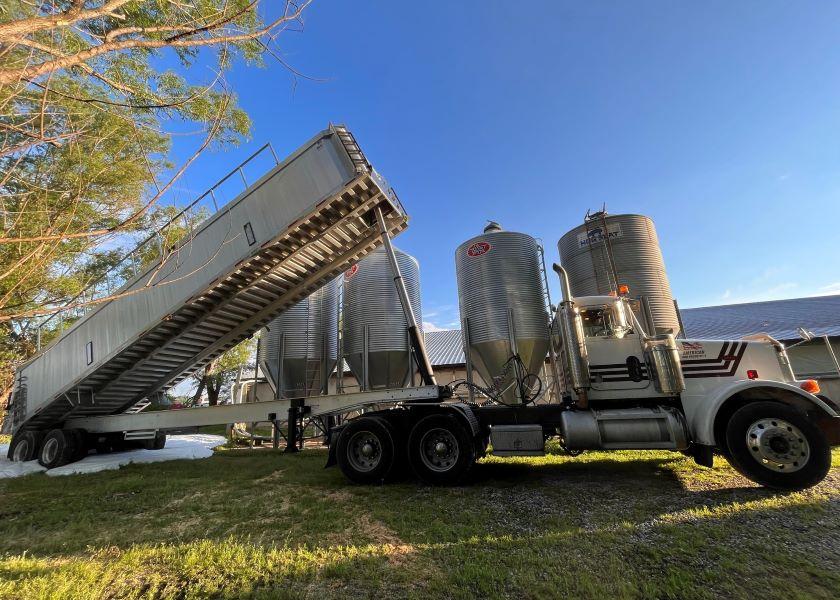Water-Based Foam Shows Promise as a Method for Swine Depopulation

Perhaps one of the most valuable lessons learned from the COVID-19 pandemic is that preparing for emergencies is very important when it comes to both human and animal health, says Jack Korényi-Both, a DVM candidate in The Ohio State University’s College of Veterinary Medicine, and winner of the American Association of Swine Veterinarians (AASV) Top Student Presenter Award at the 2023 AASV annual meeting.
“In the case of emergencies (e.g., zoonotic diseases, environmental disasters, pandemics, etc.), animal depopulation may be needed to stop disease from spreading as soon as possible. However, the methods currently available for depopulation bring important challenges when considering animal welfare, logistics, equipment, and human mental health; and research in the topic of animal depopulation is largely lacking,” Korényi-Both explains.
Ohio State’s Department of Veterinary Preventive Medicine has been trying to fill knowledge gaps regarding swine depopulation. Korényi-Both set out on a mission to do exactly that with a focus on better understanding he use of water-based foam for depopulation of swine.
Euthanasia vs. Depopulation
He’s quick to differentiate between euthanasia and depopulation. Euthanasia refers to “humane death.” Depopulation refers to the rapid destruction of a population of pigs in response to urgent circumstances.
“For any depopulation method, we are dealing with a very serious situation, and our priorities here should be that animals are unconscious as fast as possible, and that negative emotional states (measured by animal reactions/ behaviors) are minimized as much as possible,” he says. “For my project, we evaluated the applicability of a specific depopulation method, water-based foam, for swine. This is not currently a recommended method for swine, so our trials focused on understanding its use specifically as it related to unconsciousness and behavior of the animals.”
The researchers quickly realized this is not an easy task, Korényi-Both adds. To accomplish the project objectives, they brought together a team of specialists from different backgrounds, including a pediatric neurologist to evaluate and analyze brain activity in the animals, a clinical veterinarian with expertise in cardiology, and a veterinarian board certified in animal welfare to observe and quantify animal behavior during a proof-of-concept trial.
What Did the Study Reveal?
The study’s results showed water-based foam allowed for a relatively quick time to unconsciousness and brain death in pigs (under 2 minutes and 3 minutes respectively), which supports its potential use as a depopulation method.
“We also discovered that if we fill the container using faster fill rates, times to unconsciousness and brain death were faster, and we observed fewer adverse behavioral responses,” Korényi-Both says. “Similarly, applying foam at a higher height (2 times the height of pigs) also resulted in fewer adverse behavioral responses.”
Their study resulted in important logistical recommendations for use of water-based foam in depopulation if this method is recommended and approved for use, he adds.
Don’t Wait to Make a Plan
Korényi-Both urges producers to be prepared for unfortunate situations pertaining to their animal population.
“Nobody knows or understands their farm and animals like you do,” Korényi-Both says. “Carefully think about what you would do in the event of an emergency. Foreign animal diseases are constantly threatening the U.S. food supply, and the fear of African swine fever crossing U.S. borders reinforces this.”
In the case of an outbreak like this, depopulation of animals may be required to timely contain, control and eradicate disease. He says producers need to be prepared with a well-thought-out plan from biosecurity implementation to depopulation and disposal to try and decrease the stress already associated with an outbreak situation.
“The more prepared you are, the more smoothly this unfortunate process will go,” Korényi-Both says. “There are several depopulation methods available, none of which are perfect or ‘fits all scenarios.’ Having different options available can help alleviate the stress during an outbreak when considering, cost, equipment availability/safety, efficiency, personnel mental health and environmental aspects.”
Korényi-Both’s advisors and mentors include Andreia Arruda, DVM; Andrew Bowman, DVM; and Justin Keiffer, DVM, all of The Ohio State University College of Veterinary Medicine.
Korenyi-Both received a $5,000 scholarship for his top student presentation titled “Water-based foam depopulation in swine: Evaluating brain activity, animal behavior, and logistical aspects.” The Zoetis Foundation provided the financial support for the award. Additional scholarships totaling $20,000 were funded by Elanco Animal Health. Four veterinary student presenters received $2,500 scholarships: Carly Bates, Iowa State University; Hope Dohlman, Iowa State University; Taylor Jansen, Purdue University; and Rachel Kanefsky, Tufts University. Five veterinary student presenters received $1,500 scholarships: Ellen Gibbs, University of Missouri; Alyssa Ruston-Bray, University of Illinois; Gregory Shanks, University of Tennessee; Adam Tatnall, University of Illinois; and Amber Vegter, Iowa State University. Student presenters receiving $500 scholarships were Erin Russell, Lincoln Memorial University; Kendall Sattler, Purdue University; Adam Steffensmeier, Iowa State University; Mallory Wilhelm, Iowa State University; and Dylan Wulfekuhle, Iowa State University
Thirty-five veterinary students from 14 universities submitted abstracts. From those submissions, 15 students were selected to present during the annual meeting. The Zoetis Foundation provided $750 to each student selected to participate to offset the costs of presenting.
More from AASV's Annual meeting:
AASV Recap: What the Veterinarians Were Talking About
Swine Veterinarians Share Wisdom Beyond the Farm at AASV Annual Meeting
Face Next-Generation Challenges in the Pork Industry Head On
AASV Recognizes 2023 Young Swine Veterinarian of the Year
AASV Foundation Awards $100,000 for Research Grants
Tara Donovan Named AASV's 2023 Swine Practitioner of the Year
American Association of Swine Veterinarians Names Hollis President







